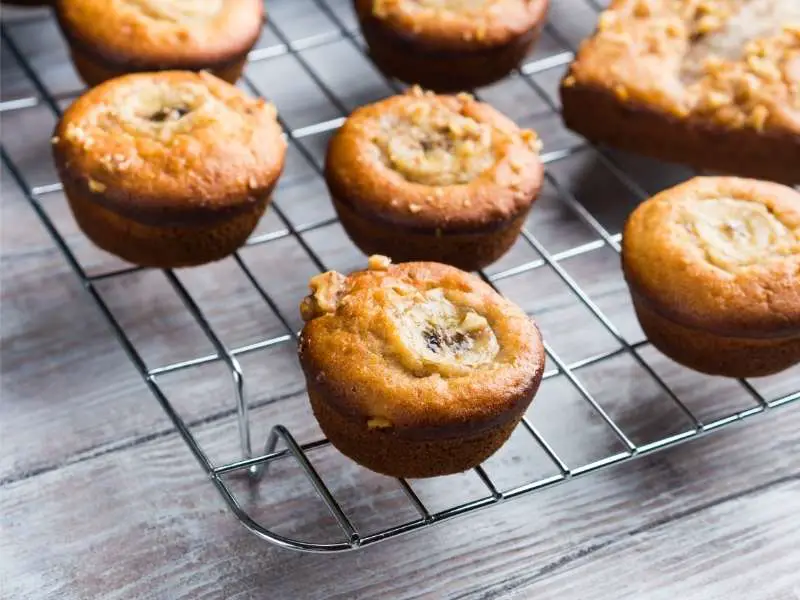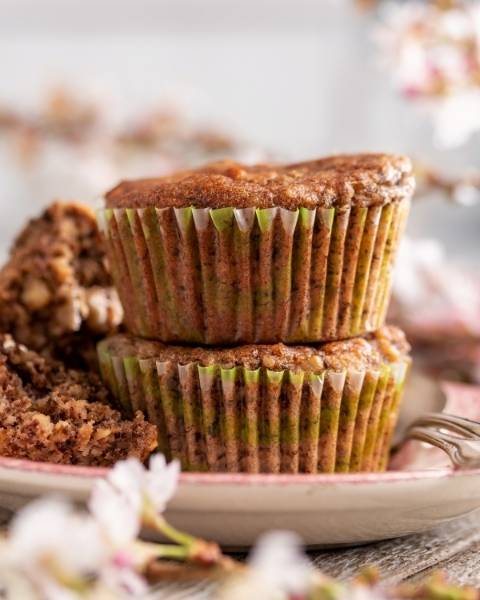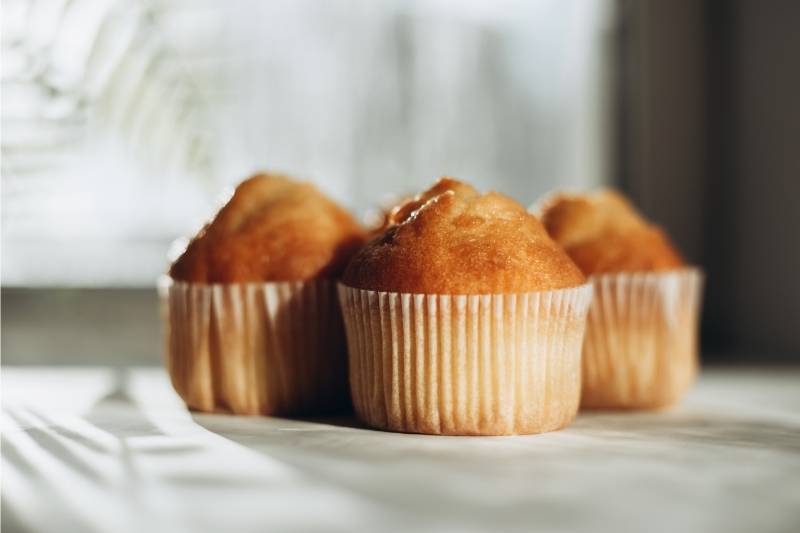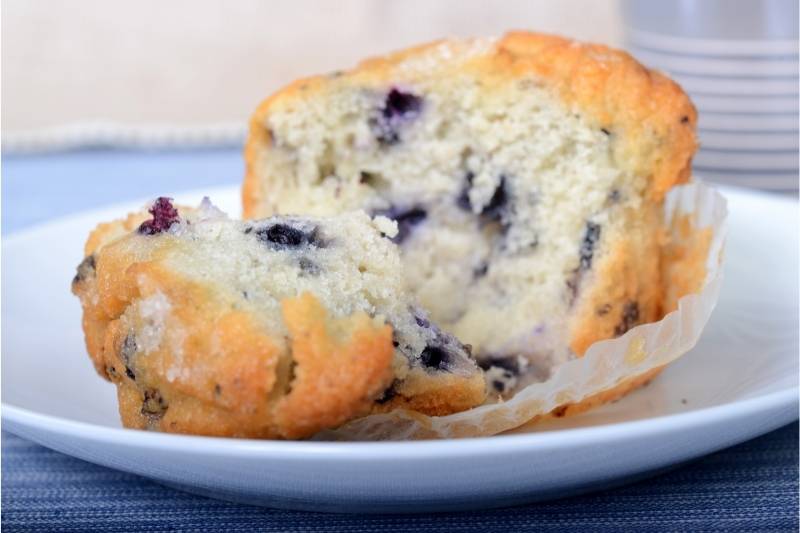This post contains affiliate links.
Getting your muffins to rise can be a daunting task, especially if you are just starting out with baking. But don’t worry, because after baking muffins numerous times and trying out different recipes, I finally figured out how easy it can be to prevent flat muffins.
As a general rule, muffins won’t rise properly if you use expired, insufficient, or wrong leavening agents in the batter. Leavening agents provide the reaction needed to make the batter rise. Additionally, overmixing or undermixing muffin batter will prevent the batter from expanding and rising.
Flat muffins are a common occurrence in the kitchen. Getting your muffins to rise higher the right way is very important for the dome-like appearance and texture of your muffins. In this article, we’ll explore why your muffins may not be rising, how to prevent muffins from being flat, and how you can fix them.
Why are my muffins not rising?
Your muffins are not rising because of the following reasons:
- You use expired, old, or very little leavening products
- You substituted baking soda and baking powder incorrectly
- Your batter is over-mixed or under-mixed
- Your oven isn’t preheated correctly
- You did not fill up the muffin tins properly
- You have the wrong recipe
During my search for the perfect muffin/cupcake, I came across a Great Nonstick 12-Cup Muffin Pan that will make my muffins/cupcakes the perfect size. Ever since I got it, my muffins came out looking better than ever before! You can find this Muffin Tin on Amazon!

Now let’s discuss these issues:
You used old, expired, or insufficient leavening ingredients
This is among the most common reasons why muffins are flat. If your baking powder or baking soda is old, it won’t work as efficiently in the batter and will cause them to not rise.
I often notice my friends using leavening products that have sat in the cupboard for months. While they will still work, both baking powder and baking soda become less effective over time.
To avoid this, you may want to buy leavening products in smaller quantities that will be used up within a few months.
Substituting baking powder for baking soda incorrectly
Most people think these two ingredients are the same, but they are actually not.
Baking soda is a base ingredient that needs an acid to react with it in order for your muffins to properly rise.
If you only have baking powder, but the recipe calls for baking soda, make sure you add lemon juice or vinegar to the mixture. This will add the needed acid component required by the mixture to get your batter up and ready.
*By the way, you might also want to know If Cornstarch Can Replace Baking Powder. I recently wrote an article about Baking Powder Substitutes That Work, you can check it out here!
Undermixing or overmixing the batter
When you mix the batter, gluten bonds form. The bonds are what hold the mixture together, giving it its elasticity and structure. However, when you overmix, you increase the binding strength of the gluten, which can make it tough for the batter to rise.
If you undermix your muffins, they may not have enough structure and therefore won’t be able to expand.
Undermixing your batter may also result in ingredients that are not evenly distributed. These uneven ingredients will lead to holes, lumps, and bumps in your baked goods.
While I like to do my mixing by hand, I much rather prefer using a Stand Mixer instead. I recently wrote an article that talks about the 3 Best Stand Mixers that bakers can buy in each stage of their baking journey. After reviewing a few stand mixers, the Best Overall Mixer was the KitchenAid Artisan Tilt-Head Stand Mixer. You can check out this stand mixer on Amazon!
Setting the wrong oven temperature
This is one of the biggest mistakes I used to make when I started baking muffins. Your oven needs to be preheated to the right temperature so that the baking powder and baking soda can react properly and release their gases to make your muffins rise.
Often, depending on the recipe, the minimum temperature is 350 degrees Fahrenheit or higher, so be sure to check your oven’s manual to determine the exact temperature.
You didn’t fill the muffin tins enough
This is another reason why you may have flat muffins. If you underfill your tins with the muffin batter, the muffins will not have enough leavening in them to rise over the top.
However, the same goes with overfilling your tin with muffin batter. When your muffin tin is too full, the batter won’t be able to expand properly in order for them to rise.
I found that filling the tins at least three-quarters of the way up works for me.
You used the wrong recipe
So you didn’t make any of the above mistakes, but your muffins still didn’t rise. You just might be having the wrong recipe.
Even if you followed the recipe exactly, it may not have been written correctly or is just not suitable for your oven. If this happens to you, try a new recipe from another source and see how that turns out.
*By the way, I recently wrote an article about How to Store Muffins to Keep Them Fresh for Longer. This article talks about the proper ways to store muffins at room temperature, in the fridge, and in the freezer to keep them fresh. You can check out this article here!
How to prevent my muffins from becoming flat?
To prevent your muffins from becoming flat, use the ingredients correctly and in the right ratios, don’t undermix or overmix the dough, preheat your oven correctly, and be sure to fill up your muffin tins properly. Additionally, make sure you use the right recipe to make the muffins rise.

Choose your recipe wisely
You want to read reviews and thoroughly go through the recipe itself to make sure it is something that can actually work in your oven.
You don’t want to just pick a recipe that sounds good and then have the muffins not rise.
Use ingredients correctly
First, you need to trust you’ve chosen the right recipe and get every ingredient that is in it. Missing ingredients can result in poorly baked, flat, or tough muffins.
Make sure you use the right leavening ingredients and check your expiration date if they are expired. This is a common mistake that leads to flat muffins.
Do not overmix or undermix the batter
It’s important that you know how long to mix things together and how much time to let it sit.
You also want to make sure that you don’t overmix or undermix your batter, which can lead to flat muffins or tough ones. Many recipes will tell you how long and how to mix the batter.
Carefully read your recipe’s instructions and make sure to set a timer for any actions that involve time. I found that setting a timer when I mix the batter helps me prevent the over or undermining of the batter.
*By the way, you might also want to know How To Mix Batter Without a Mixer. I recently wrote an article talking about The Right Ways of Mixing Batter By Hand, which you can check out here!
Preheat oven correctly for best results
Monitor your oven temperature closely. You want to make sure that the muffins are baked at the correct temperature but also not too high or too low.
As I mentioned earlier, make sure you preheat your oven properly to get it at least 350 degrees Fahrenheit or higher before putting in the muffins.
Fill up the tins correctly
Everything may be done correctly, and the muffins may actually be rising just fine, but if you didn’t fill the tins correctly, you are not going to get nice tops on your muffins.
Try filling the tins at least three-quarters of the way up to get a better rise on your muffins.
*Side Note: If you are lacking baking equipment in your kitchen, I recommend for you to consider getting yourself some Silicone Molds. Silicone Bakeware has all types of molds including Silicone Cake Pan, Muffin Tins, Bundt pans, and so much more. I recently wrote an article explaining Tips For Using Silicone Molds which you can find here!
Why do my muffins come out flat?
As a general rule, your muffins will come out flat because they are underbaked, you used inactive or insufficient leavening ingredients, or you didn’t mix your ingredients correctly. Follow the muffin recipe precisely to get the muffins to rise.
You need to choose the right recipe, use the correct leavening ingredients, and monitor how long you are mixing your batter. Also, try checking that your oven is preheated properly before baking, as well as filling up the tins enough, so they have room to expand while being baked.
Make sure you are using the right amount of eggs, flour, and other ingredients. Doing this will make sure that the batter has the right mixture of ingredients to be able to rise to look like a dome.
If you do all of these things correctly, your muffins won’t be flat and should rise like they are supposed to.
How do I get my muffins to rise higher?
To get your muffins to rise higher, use room-temperature ingredients. Using cold ingredients will mess with the batter’s reaction and create flatter muffins. Let your batter rest for no longer than 10 minutes to get the full effectiveness of the leavening agents.

Use room-temperature ingredients
Another mistake I used to make was pulling out ingredients from the refrigerator that was still cold and starting mixing my muffin batter.
I noticed using room-temperature ingredients; my muffins rose more easily. You want to make sure that when using milk or eggs in recipes, you bring them to room temperature first before putting them into the batter.
*Make sure that the ingredients don’t spoil*
Don’t let the batter rest for too long
In my experience, how long you should let the batter rest before putting it in the oven depends on the kind of baking powder you use.
For double-action baking powder, let the batter rest for 5-10 minutes before baking. For single-action baking powder, you want to put the muffins into the oven as soon as possible, or they will start collapsing.
Get the oven temperature right
This is one of the most important tips that I can give you if your muffins are not rising properly.
You need to get your oven to at least 350 degrees Fahrenheit or higher before baking them; otherwise, they won’t rise right.
Try making thicker batter
I have noticed a few times when baking muffins that the thicker the batter, the easier it is for it to rise. It may be more difficult and time-consuming, but if you want your muffins to rise higher, then try making thicker batter.
Use the correct flour ratios in recipes
Using too much flour can also lead to flat muffins because it absorbs some of those important gases that help them rise. Be sure to follow your recipe’s flour ratio when making muffins.
You want to make sure that if it calls for three cups of flour, you use exactly three cups and not more or less than that amount.
*Side Note: I recently wrote an article about Why Do Muffins Come Out Sticky & Soggy. This article talks about different ways to fix and prevent muffins that are sticky and soggy. You can check out this article here!
Why are my muffins so dense?
Muffins are dense because of too much liquid in the batter, overmixed batter, or too many leavening agents. If the batter is too wet, it will start sticking together once put in the oven. Follow the recipe’s instructions to achieve the correct ratio of dry to liquid ingredients.

There is too much liquid in the batter
This is among the most common reasons why your muffins are too dense. If you want them to come out nice and fluffy, make sure you follow the correct ratio of dry to liquid ingredients according to what is in your recipe.
You may also find that adding extra baking powder or even some vinegar can help lighten up a batter if there’s not enough liquid in it already.
The batter is overmixed
Overmixing the batter will introduce more air pockets into the dough, which will result in a denser muffin. You want to mix your batter as little as possible until all of the ingredients are fully combined together.
Undermixing the batter will create clumps
There’s too much leavening ingredients
If you used too much baking powder, it would cause the batter to expand too quickly and become dense. This is another reason you strictly need to follow the recipe’s correct amount of leavening ingredients.
*By the way, I recently wrote an article about How to Store Muffins to Keep Them Fresh for Longer. This article talks about the proper ways to store muffins at room temperature, in the fridge, and in the freezer to keep them fresh. You can check out this article here!
To Summarize…
Your muffins may turn out flat because of several issues that start from choosing your recipe, getting the ingredients, to filling up the muffin tins.
Getting your muffins to a dome-like appearance is every baker’s goal. So be sure to follow all of these tips, and I’m sure your muffins will come out nice and fluffy. Hopefully, this article will help you prevent flat muffins in the future.
